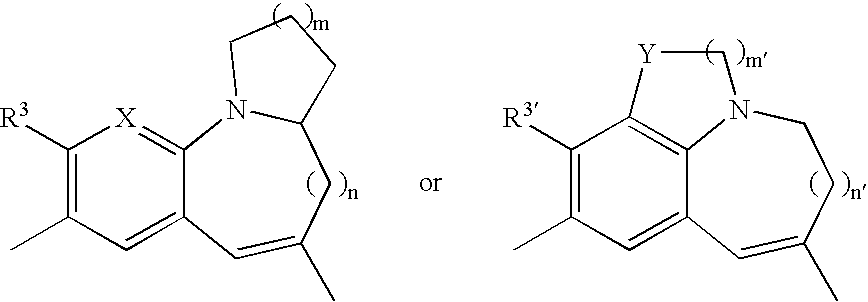Tricyclic compound, process for producing the same, and use
a tricyclic compound and anti-ccr technology, applied in the field of new cyclic compound with ccr5 anti-activation activity, can solve the problem that the treatment is still not efficient enough for the elimination of aids
- Summary
- Abstract
- Description
- Claims
- Application Information
AI Technical Summary
Benefits of technology
Problems solved by technology
Method used
Image
Examples
example 1
Preparation of Compound 1
[0288] To (S)-4-[[(1-propyl-1H-imidazol-5-yl)methyl]sulfinyl]aniline di-p-toluoyl-D-tartrate monohydrate (1.66 g) was added 1 N hydrochloric acid (9 ml), and the mixture was extracted with ethyl acetate. To the aqueous layer was added an aqueous 25% potassium carbonate solution (9 ml), followed by extraction with ethyl acetate-2-propanol (4:1) three times. The organic layer was washed with saturated brine, and dried over magnesium sulfate, which was concentrated under reduced pressure to give (S)-4-[[(1-propyl-1H-imidazol-5-yl)methyl]sulfinyl]aniline as a colorless amorphous material.
[0289] To a solution of 8-[4-(2-butoxyethoxy)phenyl]-2,3,3a,4-tetrahydro-1H-pyrrolo[1,2-a][1]benzazepine-5-carboxylic acid (700 mg) in THF (10 ml) were added thionyl chloride (0.18 ml) and DMF (one drop), and the mixture was stirred at room temperature for 1.5 hours. After concentration under reduced pressure, a solution of the residue in THF (30 ml) was added dropwise to a su...
example 2
Preparation of Compounds 2 and 3
[0293] (Ss)-8-[4-(2-butoxyethoxy)phenyl]-N-[[4-[(1-propyl-1H-imidazol-5-yl)methyl]sulfinyl]phenyl]-2,3,3a,4-tetrahydro-1H-pyrrolo[1,2-a][1]benzazepine-5-carboxamide (Compound 1) (350 mg) was optically resolved by using CHIRALPAK AD (50 mm ID×500 mmL) (elution solvent, methanol). The fraction was concentrated into dry solid, and the residue was dissolved in ethanol, which was filtered by a 0.45 μm filter. The filtrate was concentrated to give two diastereomers of Compound 1 [the former fraction: diastereomer 1 (Compound 2) (170 mg, >99.9% de) and the latter fraction: diastereomer 2 (Compound 3) (170 mg, >99.9% de)].
[0294] Compound 2: [α]D=−503.3° (c=0.546%, chloroform solution)
[0295] Compound 3: [α]D=+249.1° (c=0.470%, ethanol solution)
example 3
Preparation of Compound 4
[0296] To (S)-4-[[(1-propyl-1H-imidazol-5-yl)methyl]sulfinyl]aniline di-p-toluoyl-D-tartrate monohydrate (1.0 g) was added 1 N hydrochloric acid (9 ml), and the mixture was extracted with ethyl acetate. To the aqueous layer was added an aqueous 25% potassium carbonate solution (9 ml), followed by extraction with ethyl acetate-2-propanol (4:1) three times. The organic layer was washed with saturated brine, and dried over magnesium sulfate, which was concentrated under reduced pressure to give (S)-4-[[(1-propyl-1H-imidazol-5-yl)methyl]sulfinyl]aniline as a colorless amorphous material.
[0297] To a solution of 9-[4-(2-butoxyethoxy)phenyl]-1,2,3,4,4a,5-hexahydropyrido[1,2-a][1]benzazepine-6-carboxylic acid (500 mg) in THF (10 ml) were added thionyl chloride (0.126 ml) and DMF (one drop) at room temperature, and the mixture was stirred for 1 hour. After concentration under reduced pressure, a solution of the residue in THF (30 ml) was added dropwise to a suspens...
PUM
 Login to View More
Login to View More Abstract
Description
Claims
Application Information
 Login to View More
Login to View More - R&D
- Intellectual Property
- Life Sciences
- Materials
- Tech Scout
- Unparalleled Data Quality
- Higher Quality Content
- 60% Fewer Hallucinations
Browse by: Latest US Patents, China's latest patents, Technical Efficacy Thesaurus, Application Domain, Technology Topic, Popular Technical Reports.
© 2025 PatSnap. All rights reserved.Legal|Privacy policy|Modern Slavery Act Transparency Statement|Sitemap|About US| Contact US: help@patsnap.com



